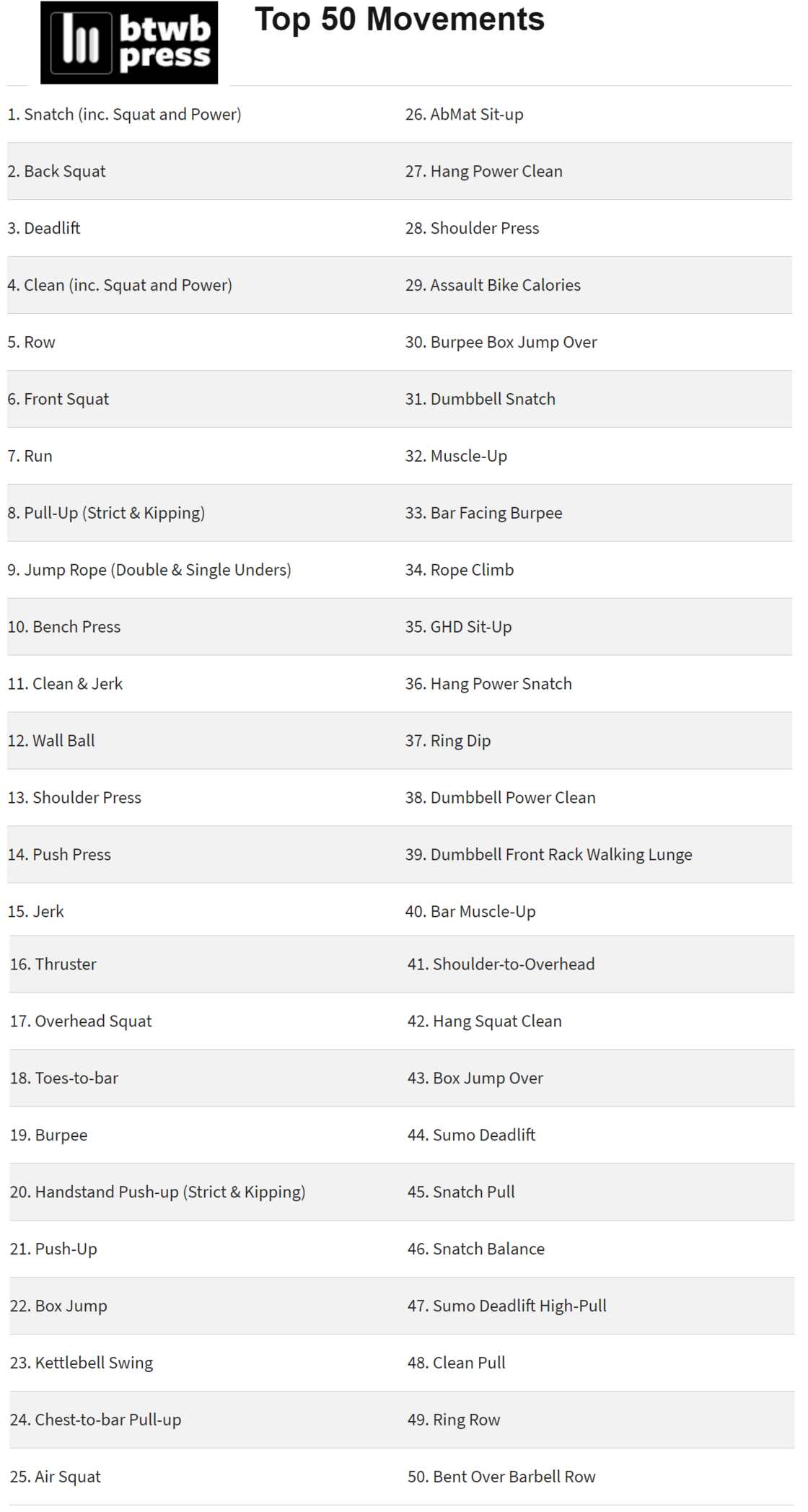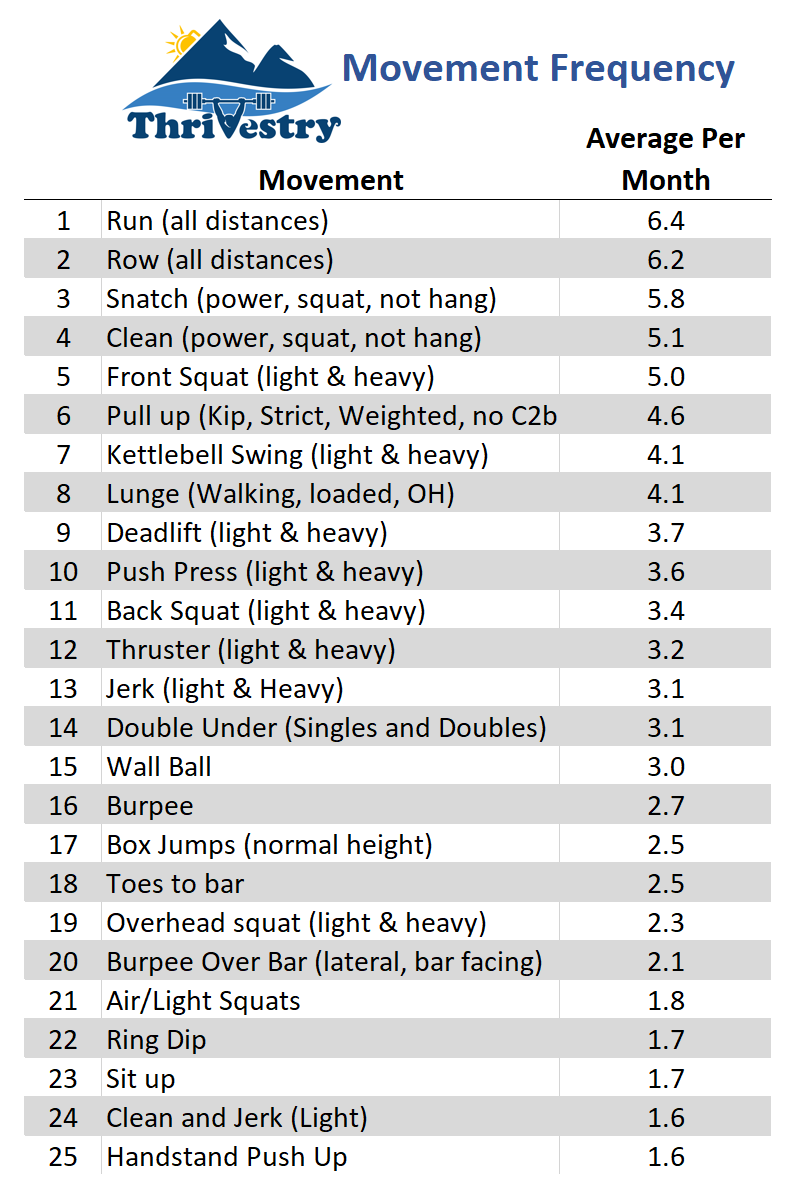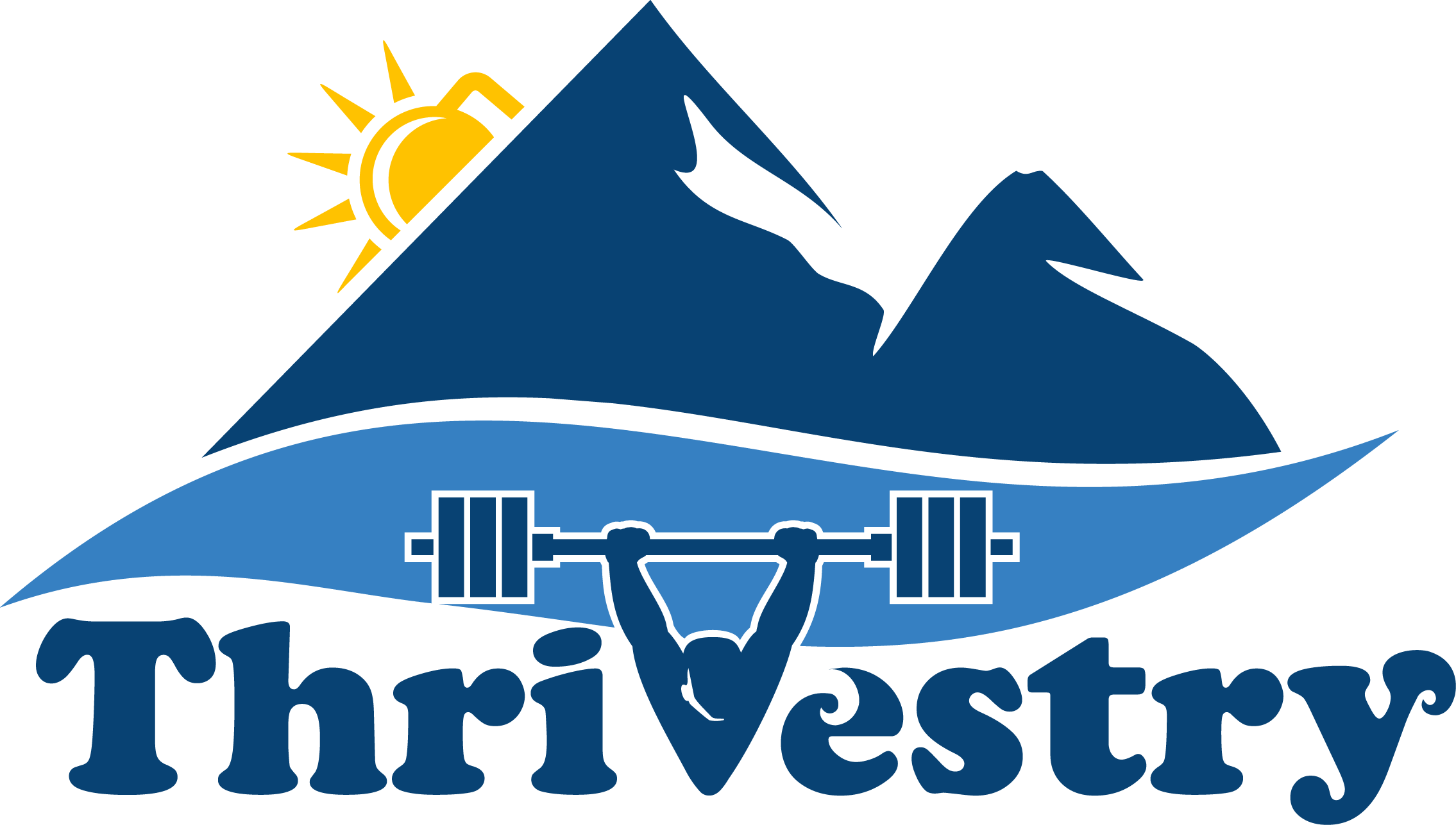Movement Frequency in Thrivestry Compared to Other CrossFit Programs
![]()
(One of my many code powered spreadsheets I use to create programming)
It should be obvious by now that I love data and numbers (so you don’t have to), but I’d like to take some time today to break down some numbers ‘behind the curtain’ so you can understand some of the data behind what we are doing, as well as how it is different than many other programs out there.
These thoughts were spurred on by the awesome post by the folks at Beyond the Whiteboard. Head on over there to see what most CrossFitters are up to regarding movements, workouts, time domains, etc! See their year end review here.
Today, I’ll be honing in on the movements themselves. Here is a summary of the top 50 movements logged on BTWB for 2017 as well as my top 25 from a monthly frequency standpoint.


Now if you look at the snapshot at the top of this article, you’ll notice that I track my movements differently than they way they do (I have 5 categories for the clean for example, and I don’t overlap squat cleans and power cleans). I also keep track of the average frequency per month to make sure that people are getting the correct volume per movement and there isn’t any ‘holes’ in people’s fitness.
Using that data, I was able to come up with a similar report to what Daniel came up with using the aggregate data from all of the stuff logged on BTWB. My report comes from my own spreadsheet data.
There are a couple of things to keep in mind here. First, BTWB is only able to know what people logged. I believe that means that there is going to be a bit of a skew toward lifting movements because people like to log those often to see progress, and there is a good chance they may log a lift and a metcon both in the same day with that movement. I’ll also point out that my numbers are for lifting and metcons for the most part. I generally do not count skill practice warm ups as part of this. My monthly frequency is from the last 2 years. I have data like this going back well over 5 years, but I figured that 2 years was enough.
Running and Rowing… REALLY!?
The first thing you’ll notice is that running and rowing are at the top of my list. The reason that we run/row more often than many other programs is that is because it is one of the safest ways to create intensity and cardiorespiratory adaptations, especially when added to the beginning or ending of a workout. So while some people see Thrivestry’s programming of a lift and a short metcon about half of the days as a ‘strength bias’, we aren’t ignoring the metcon piece by any stretch!
I also think that that we do more runs than most is because I have found that runs 200 meters and under are underutilized in many programs. The vast majority of workouts in other programs are dominated by 400m and 800m runs compared to shorter, more intense, sprints.
Front Squats vs Back Squats
The next difference is that I place a much higher emphasis on front squats than back squats compared to many. I have found that while the back squat enables people to lift more load, the front squat has much more ‘carry over’ to other movements (especially in regards to ‘functional fitness’). Thrusters, wall ball, push press, cleans, snatches, carrying a box… all of these things require the ability to stabilize the weight out in front. How often are we squatting or carrying loads on our spine?
I have also found that people who do many more back squats than front squats (especially of the low bar back squat variety), end up with issues on other movements. They’ll lose a lot of their cleans out in front. Their low backs will blow up on wall balls. They will throw the jerk out in front more often…
It isn’t that we don’t want to do back squats (you can see they are just out of the top 10 on my list), but for regular folks coming in 2-4x per week on average, front squats are going to pay off more than back squats in the long run.
Deadlifts
The fact that deadlifts are showing up a bit ‘low’ needs some explaining. First, I’d like to point out that I did not include single leg deadlifts into my calculations. That would have moved it up significantly. Second, I believe that heavy-ish deadlifts are over used in many CrossFit metcons.
In the last 12 years or so, I have seen far too many people end up with back issues from getting sloppy on deadlifts in workouts and/or going for a PR on heavy deads. Sometimes we can point to the gym or the coach for letting people do ‘not perfect’ form, but I’ve found that in general, the risk to reward isn’t worth it. People will have to go so slow on the metcon, or drop the load so much, that they won’t get the correct stimulus for that workout.
That being said, when it comes to posterior ‘hinging’ movements and glute work, you’ll notice that I use a lot more lunges and kettle bell swings…
Lunges and Kettlebell Swings
Suspiciously absent from the BTWB list are the lunges. Now it could be that they have so many variants added (more than just db front rack), it is just that they are outside of the top 50. But, clean pulls, snatch balances, and bent over rows are on here and not walking lunges and/or step ups?
Lunging and step up variants should be considered crucial to human development. Much (if not most) of life outside of the gym happens with our legs having to work independent of each other. People walk up and down the stairs, sprint to catch the bus, etc., FAR more often than they squat up and down with both feet planted!
With regard to the swings, I wonder if the kettlebell swing ended up so low because I combined Russian and American Swings for my list. But I also suspect that the swing may be a bit under utilized because it isn’t likely to show up in the CrossFit Open…
There Seems to Be a Trend…
And I believe this is confirmed when you look at the most logged workouts later in the BTWB article… A lot of people are programming Open workouts or workouts that are geared toward the Open.
Front rack dumbbell walking lunges in the top 50!? Burpee box jump overs?! Have you tried to fit 15+ people into a regular sized gym and done burpee box jump overs?! They take up way too much space!
Why are ring muscle ups ahead of ring dips and rope climbs!?
I think this is an indication of a larger trend that we have seen for years: The emphasis on CrossFit Competition when it comes to CrossFit Programming!
Program for the Rest and Scale Up for the Best
I am a firm believer that the needs of the vast majority of folks, especially for the long term, is significantly different than the demands of the ‘Sport of Fitness’. Thrivestry programming is designed to help people have more awesome lives, not just get better at the movements that end up at the different levels of the CrossFit Games.
People seem to forget that from the beginning of CrossFit (certainly when I started in 2004), until about 2008, ‘competitions’ didn’t exist (beyond some thrown together ‘throwdowns’ where locals got together).
We all only did CrossFit because it made us better at other activities, it helped us look better in our bathing suits, it was fun to do, and it didn’t take a lot of time to get results (time spent at the gym and time to see/feel changes)!
I do hope that the CrossFit community as a whole can get back to the original mission, while appreciating the sport as a separate (but awesome) example of what can be achieved for those who want to specialize in it.
In the meantime, you guys and gals keep leading the charge by taking care of your regular folks and teaching them the differences between becoming ‘fit’ and competing in fitness!
Bonus Round
This article has already become longer than I intended, but I did want to elaborate a bit further on the movement patterns. The problem with breaking the movements out specifically is that it doesn’t show the whole picture.
For example, at first glance, both of the lists above make it look like we don’t have people squat as much as clean and snatch. The reality is that I have 10 separate types of squat specific movements that I track as well as the ‘compound’ movements like thrusters and wall ball.
If someone doesn’t acknowledge that wall balls are a type of squat, there is a chance that they could program a squatting movement every day of the week or put too many in a single workout! Not to put CrossFit.com on blast, but the January 12th 2018 workout is Complete as many rounds as possible in 20 minutes of: 20 medicine-ball cleans, 60 double-unders. Do they realize that a medball squat clean is actually two squats per rep? 40 squats per round for 20 minutes is going to cause crazy amounts of soreness and even risk Rhabdo for some folks! Most of the people posting there got 7 – 9+ rounds (that is to 280 - 360 squats)!
Here is another list pulled from my spreadsheet data. This one has the gross movement patterns that we should be thinking about. Some have been combined for simplicity. For example, this chart has all upper body presses combined into one row.

You can see here that squatting and pressing are pretty high on the frequency list. I also want to point out that if you add the lower body pulls and hinges (very similar movements) combined actually do come out to 30 combined. So about the same as the squats! I’ll also add again that I didn’t include the dynamic warm ups or skill practice warm ups in these calculations, but you’ll notice that we do a lot more upper body pulling in those parts of the class to help balance out all of the pressing we do.
Bonus Bonus Round
After posting this to my private 'subscriber only' part of the website I got a clarification request:
I LOVE this article. It has clarify so much on why we’re doing not as much Deadlifts as my members would like to see. I love that you are programming for the rest and scale up for the best.
With that said, we have some of “THE REST” group who dropped out because they’ve lost interest in doing the snatch or the jerk totally. They lost interest in trying mobilise their shoulders do go overhead so often. The snatch is ranked at 3 and , If you combine jerk and push press, the movement would be ranked at 3rd kicking the snatch down to 4th.
Is there a reason behind having so much overhead work? Could we perhaps add more upper body pushes in a horizontal plane rather than vertical? Or horizontal pulling such as Bent Over Row?
My response:
I've found that there will always be people who 'opt out' of certain movements for what ever reason. We can combat it with education and specific work to make them better, but ultimately it is up to them. A LOT of the time people will skip a movement entirely, not because they couldn't learn how to do it, or because they are injured... but because their ego has been injured at some point and they've worked it out in their head that the movement isn't for them.
In the case of something like jerks (but they can still go overhead), have them use less weight and do push presses. If snatches aren't their jam, do the clean variants, or even Kb swings.
The main reasons why we do more vertical pressing vs horizontal pressing is that vertical pressing tends to be more 'primal'/natural/functional (with a bit less overuse injuries), and that horizontal pressing is a really isolated movement pattern with not many variations that make sense in a metcon.
Also keep in mind that these lists combine strength and metcon use of the movement. That is the way that BTWB cut up the data.
To elaborate further on the first points,.. When doing push ups or bench press we are really isolating the arms and not allowing any sort of 'kip' or assistance from the rest the body. When doing overhead work, the shoulder press is about the only variation that is similar. Push presses, jerks, kipping hspu, all aren't 'pure' pressing movements that isolate the flexion of the arms.
For metcons, when we are trying to build intensity, compound, muilti joint, movements are better. This is why we don't do that many strict shoulder presses in workouts (or Strict single arm shoulder presses for that matter). We want the 'kip' or the other limbs to get involved to jack up the cardio respiratory component.
As far as horizontal rowing, this is why we do so many single arm ring rows, ring rows, db and bb rows, in the dynamic warm ups and super sets. Rowing on the rowing machine is also a horizontal pull... But in general the horizontal pulls do not lend well to metcons (and why just doing metcons for training as some folks do... and call it a 'metcon bias'...), it will almost always lead to injury.
By including it in the full lesson plans and beyond just the lifting and metcons, we actually balance out the pressing and pulling so we get a 1:1 or even a 2:1 Pull to press ratio.
This is turning into another long article! Probably makes more sense for me to make a video some day...
ULTIMATELY...
If someone is avoiding overhead movements (and they don't have a good medical reason), eventually their body will give them a medical reason to never go overhead!
If you don't use it, you lose it!
People who cannot go overhead without pain, will only get worse over time if they don't do anything to fix this. It is our job to educate and fix people so they don't end up with major issues down the road!
I hope all of this helps explain some of the details of the Thrivestry program and how we make sure we are creating ‘balanced’ humans while avoiding injury and having fun!
Thrive on.
-jj

0 comments
Leave a comment